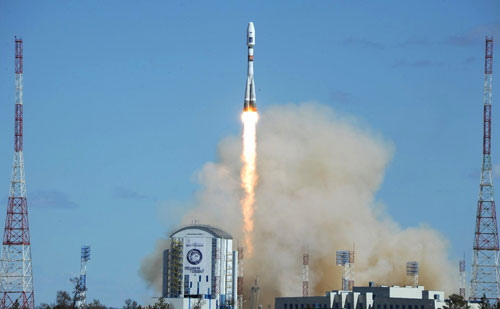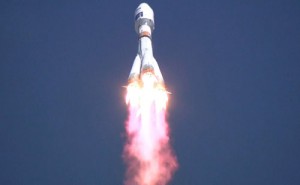
Russian Space Observatory Launches
Russia's Mikhailo Lomonosov observatory takes to the skies on the hunt for gamma-ray bursts, cosmic rays, and near-Earth asteroids.
 A Soyuz 2-1A rocket thundered skyward on Thursday, carrying three satellites into orbit, including the Mikhailo Lomonosov astrophysics observatory. Named after a Russian 18th-century writer and scientist (known, among other things, for his observations of the 1761 Transit of Venus), the Lomonosov has a three-year primary mission. Its motley array of instruments will monitor everything from the speedy particles known as cosmic rays to the asteroid hazard around Earth.
A Soyuz 2-1A rocket thundered skyward on Thursday, carrying three satellites into orbit, including the Mikhailo Lomonosov astrophysics observatory. Named after a Russian 18th-century writer and scientist (known, among other things, for his observations of the 1761 Transit of Venus), the Lomonosov has a three-year primary mission. Its motley array of instruments will monitor everything from the speedy particles known as cosmic rays to the asteroid hazard around Earth.
The launch, a first for the new Vostochny Cosmodrome in Siberia, occurred on April 28th at 2:01 Universal Time following a one-day delay. Located near the Chinese border, the Vostochny spaceport will eventually host the Angara rocket, Russia's next heavy-lift vehicle slated for its inaugural launch in 2021. Russian President Vladimir Putin witnessed Thursday’s launch and offered his congratulations to the team, saying, “We have reason to be proud.”

Russian president Vladimir Putin watches the launch.
http://en.kremlin.ru/
http://en.kremlin.ru/
Operated by Lomonosov Moscow State University in concert with agencies in six other countries including the United States, Mikhailo Lomonosov was built around a surplus Russian Kanopus-style satellite platform. After the launch, the satellite was successfully deployed in a Sun-synchronous polar orbit. This is a highly inclined retrograde orbit that precesses 1º per day, which enables the spacecraft to view Earth at the same local time on successive passes.
“Today is an important day not only for Lomonosov Moscow State University, but also for the entire country and science in general,” said Viktor Sadovnichy (Lomonosov Moscow State University) in a press release. “The real space program at the Moscow University started with the launch of our own satellites . . . no university in the world has such [a] cosmic science lab.”
Science from the Lomonosov Satellite

The launch of the Soyuz-2.1a carrier rocket from the Vostochny Cosmodrome.
http://en.kremlin.ru/
http://en.kremlin.ru/
Mikhailo Lomonosov will observe Earth, as well as peer into the depths of the universe. Its primary goal is to observe the high-energy regime, including gamma-ray bursts, cosmic rays, and the source of elusive atmospheric flashes known as Transient Luminous Events (TLEs) on the nighttime side of Earth, often referred to as “upward lightning.”
We've only observed TLEs in the past few years, and their trigger is still unknown. Studying the phenomena will help scientists understand radiation hazards at altitudes of 10 to 20 kilometers. Mikhailo Lomonosov also carries detectors to better characterize geomagnetic storms, major disturbances in Earth’s magnetic fields instigated by changes in the solar wind.
In addition, the satellite is equipped to carry out simultaneous studies of gamma-ray bursts in both optical and gamma-ray wavelengths in a manner similar to NASA's Swift satellite. The spacecraft will even monitor the area for potentially hazardous asteroids.
Some of the key astrophysical instruments onboard are:
- TUS (Transient Ultraviolet Setup), a 1.8-meter telescope that will capture ultraviolet rays to study the interaction of high-energy cosmic rays in Earth's atmosphere. TUS’s will see 6,400 square kilometers of Earth at a glance, and the instrument is four times more sensitive to nightside flashes than traditional video.
- UFFO (Ultra Fast Flash Observatory) contains two components: the UBAT (UFFO Burst Alert Telescope) will glimpse brief gamma-ray bursts in the 5 to 200 kiloelectron-volt energy range, and within one second of a burst alert, the Slewing Mirror Telescope will follow up with immediate ultraviolet observations.
- ELFIN-L (Electron Loss and Fields Investigator for Lomonosov) is a joint project fielded by Lomonosov Moscow State University and the University of California Los Angeles. The goal of ELFIN-L is to better understand the hazards to humans and satellites posed from energetic ions and electrons in near-Earth space.
- BDRG is a gamma-ray burst detector which can narrow down an event to within a three-degree field of view for the optical cameras.
- ShOK is a wide-angle camera with a 1,000-square-degree field of view. ShOK can capture visible-light counterparts for gamma-ray bursts, but it may also capture supernova events, space junk and asteroids passing as well.
It might seem strange to have so many goals for a single spacecraft. But launches of Russian scientific satellites are rare these days, so scientists opted to put a lot of instrumental eggs in this one basket.
The scientific data Lomonosov collects will be freely available to the international scientific community. An integral scientific project, expect to hear more from this project in the years to come.
No comments:
Post a Comment